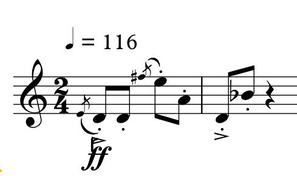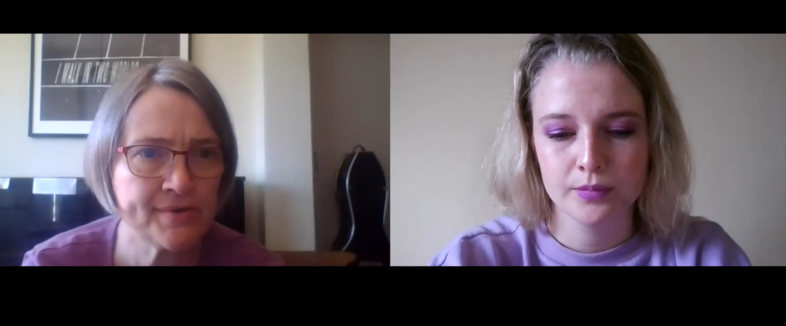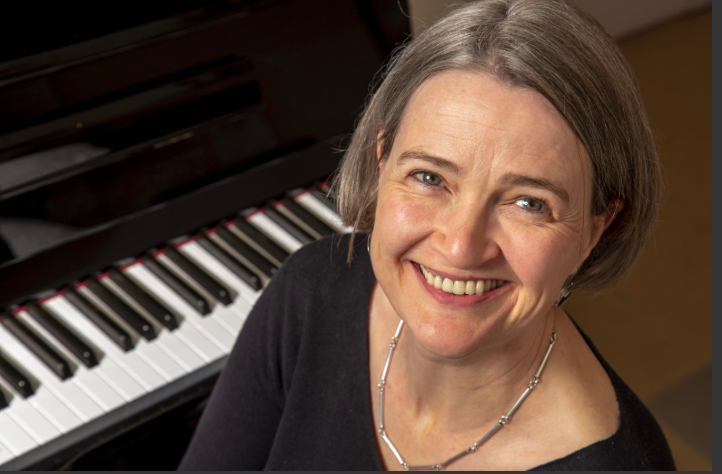Reflection from the composer
“I can't tell you how happy it made me writing this piece. It's just like "Ah! Ah!". This is my happy place. I mean, I wrote it so quickly. It just felt all lovely and settled. And no, I just -- I loved writing this piece” (Loveday, 2021).
Loveday remarked the following after a discussion as to whether or not this piece is an example of South African Art Music:
"In brief, it was written in South Africa. It is art music. So, it must be South African art music?" (Loveday, 2024).
A Brief Analysis of the Score in terms of Themes (From my Interpretational Reflections) + composer feedback
Dualism
“Partly because it’s for alto saxophone. And alto saxophone so often is - can be - a bit sort of in between, you know, and it actually can be - it can be so powerful…The thing about the alto is it's so varied. It can have that beautiful light delicacy, but it can also be really in your face. So, I wanted to, to draw attention to both of those. And then I want you to play with the acciaccaturas. And then I always like to have two sorts of little contrasting elements and I wanted long notes because there's so much you can do with a long note. And so on and so on.” (Loveday, meeting 1, 2021)
A prominent element in this work is the idea of dualism. The piece begins by stating the two contrasting motifs:
Motif 1 Motif 2
Space
I found that the use of space interms of Loveday’s implementation of rests as well as longer rhythmic values created a sense of “space” intersecting the faster moving passages.
This can be seen in the following figure examples:
Loveday had the following to say after asking her about her stance on the idea of "space" as a compositional tool in her work:
“...This goes back a long way because one of the things I find quite frustrating about stages as a place for playing music is that they're very two dimensional... this doesn't mean this piece is, in particular, trying to do that. But I've for a long, long time -for about -I don't know, 20 years, I've been thinking about that sense of space you get in a place like South Africa so in particular like the Eastern Cape, when you that you-- How do I describe this? My grandparents had a farm. God, this is so like, South African, isn't it?...I always remember as a child and older, listening to people call each other across the hills. So, somebody would show one hill and it would kind of echo across to another hill and there was this amazing sense of space in the sound... My uncle would call out to cattle or whatever, and there would be the sense of space in the transmission of the sound...Thinking back to that, that I'm trying to make that sense of space between the hearing of the sound... I don't really 100% know if it works on a European stage because, of course, you don't have that sense of space. But that's how I'm doing it” (Loveday, 2024)
Harmony… or the lack thereof.
I asked Clare if the piece had any specific harmonic centre to which she replied: “Harmonies. If I hear a thing and it sounds nice, then I use that and then because I'm a pianist and I use a chord, and then I just sort of fiddle around until I find progressions. Okay, I don't I don't structure it. To me. That feels a bit like theory to use University” (Loveday, 2024).
My Final Reflection
This collaboration was fulfilling for me. Clare was open to my ideas and suggestions. She cultivated a piece that catered for me and my playing needs. I felt a great sense of artistic expression when playing this work even though the initial interpretation was sometimes difficult. I hope to work with Clare on future projects.
Introduction
In my first year of bachelor studies (in South Africa), I remember Loveday came to Stellenbosch to give a seminar on her works. She is very passionate about women’s rights and representation in the music industry as well as her deep love for the saxophone. She left quite an impression on me. When I decided to pursue my Master’s studies in Stellenbosch, I knew I had to work with her.
She is a well-known compositional force - especially in the South African classical saxophone community - for her contribution to the repertoire and her whimsical enthusiastic demeanour. This is evident with regards to my research with the SA saxophone catalogue, and the large number of works she has written (which can be found here). Clare affectionately refers to the classical saxophone as the “straight saxophone”.
At the beginning of 2021, I began with an email: asking Loveday if she would consider working with me on a commission. She responded with a resounding: YES! This began a two-year journey of back-and-forth discussions regarding this work and the final presentation of the artistic product in July 2023. I have written about the process in my previous research so I will give a brief breakdown of the collaboration. Owing to the COVID-19 pandemic, I was unable to perform the work, therefore I have decided to include this commission in this research project. This was one of the first works I had ever commissioned and sparked the fire for my love of collaborative commissions.
The Collaborative Process
Loveday’s extensive experience in writing for saxophone led to the rapid production of the first draft. Loveday is based in Johannesburg which was approximately 1300km from where I was situated in the country. Therefore, all correspondence was conducted via Zoom. We had several "meetings" and an abundance of correspondence via email.
Meeting 1: 26 May 2021
The first meeting consisted of Loveday and I becoming acquainted with one another and discussing my research trajectory as well as ideas for the commission. I explained that I wanted to have a work that was for solo saxophone. Loveday had the idea of expanding a previously written composition into a whole new project describing this piece as being a “stand-alone” work:
Anyway, I got this commission for a one-minute piece, but I think it's got legs and I think it could expand into something further” (Loveday in McClure, 2023: 52).
We discussed the potential of extended techniques such as multiphonics, and slap tonguing and how they could be utilised in the piece potentially if there were sections of long tones.
“I think, let's see how it goes. But my suggestion would be that as what I generally like to do is to write a piece because there's a lot that you start with that you think is fabulous that you then discard and I don't want to waste your time, you know. So, what I need to do is write a first draft and see. You have a look and you say, “This isn't working. What about this? We could try this on this long note or this might work better, you know? Fine. Also, don't be scared to say I'm finding this really hard” (Loveday, 2021 in McClure, 2023: 53).
Reflection on meeting 1:
Before this meeting, I was rather nervous. Speaking to Clare - someone I greatly respected - was quite daunting in its own right! Being a shy person, its sometimes difficult for me to directly say what I want or direct meetings efficiently. Although, I eventually was calmed by Clare's friendly demeanour and reminded of the task at hand: initiating a collaboration. This proved the easy part as Clare was incredibly enthusiastic about my research and writing a new piece for me.
Meeting 2: August 2021
Loveday had sent me the first draft a few days prior to this meeting. The draft can be viewed on the right. She wanted to surprise me and revealed nothing of the work. She did not want her input influencing my opinion (McClure, 2023: 53). At first glance, I noticed that she did not implement the use of multiphonics, slap tonguing or top tones.
In the meeting, we discussed Loveday’s influences. I could see that this piece was heavily influenced by the previously discussed One Minute Saxophone - although the material was more developed. She described the piece as sounding like “an urban street in the middle of the day” (McClure, 2023: 54). She also referred to the acciaccaturas as being something she has not successfully incorporated into her previous music, until now. Loveday intended the piece to be bold and assertive avoiding anything that sounded too "wispy" or "delicate". We also discussed extending the range into the top tones. Loveday said that she would investigate this. She did not want to use extended techniques for the sake of using extended techniques. She was careful in her implementations of the compositional techniques in terms of how they fit in the piece (Loveday, 2021 in McClure, 2023: 56).
Final Draft and Communication: 8 December 2021
Loveday sent me an email with the final draft and a short note:
"Not much has changed - just a few tweaks here and there. I agonised about including slap tonguing, but it just doesn't work - the groove gets lost and the energy drops. Better, I think, to focus on the existing articulations and make them as extreme as possible. I popped in a few altissimo register runs, which I rather like. This piece really is about subtlety, drawing attention to the saxophone's breadth of expression and, in parts, its whimsical side. I imagine you on stage, letting rip with those punching accents, then seeming to pull those light running passages from the air, as though they happened to be passing and you reached out and caught them” (Loveday, email correspondence, 8 December 2021).
After viewing the final draft, I noticed that there were minor changes - in fact, almost nothing had changed. Some of the descending passages were extended into the top tone register with the highest note being an A. Now it was time to learn the piece.
I was originally planning to premier this piece in 2022 - although this did not go as planned as there were still the lingering effects of COVID-19 restrictions, auditions and the impending deadline of my master's thesis. I also received news that I successfully auditioned for The Hague - which was great excitement but also put a hold on any concerts I would have planned. This led to some frustration from Loveday who wanted me to have already premiered the work in 2022.
Reflecting on this now, I am grateful for this delay. If it were not for this delay, I would not have had the chance to premier several new works in a single evening.
The bolder, assertive material consists of quaver notes that are broad, heavy and punchy, often ornamented with acciaccatura. They are often indicated at fortissimo or forte with accents.
The second motif is often indicated by legato passages of triplet
semiquavers. The middle section of the piece makes substantial use of this lighter, wispy more delicate material.
Based in Johannesburg, Clare Loveday is one of South Africa’s most active and internationally acclaimed new music composers. Striving to convey through music the complications of life in an post-colonial society, her works have been described by critics in turn as ‘obstinate and fierce, big-boned and raw’, ‘subtle’ and ‘elusive’.
She is best known for her ‘straight’ saxophone compositions and interdisciplinary collaborations, has worked with several award-winning artists including Gerhard Marx and Nandipha Mntambo, and has been involved in numerous projects with William Kentridge at the Centre for the Less Good Idea since 2018.
She has received awards, grants and commissions from organisations such as the Mellon Foundation, SAMRO Foundation and numerous performers and ensembles around the world. She has had works performed throughout South Africa and in Australia, Europe, England and the US, including at the ISCM World New Music Days, Juilliard New York, the Royal College of Music in London, Festival d’Automne à Paris and the Venice Biennale Architettura 2023.
Clare lectured music theory and composition for many years at Wits University and was awarded a Doctorate of Music in 2009. Recently, she worked on a collaborative commission from the Royal Opera House, London, and is a research associate at Africa Open Institute at Stellenbosch University.
















